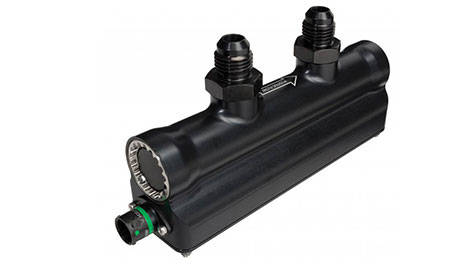Today we take a closer look to the infamous fuel flow sensors; the device that led to the disqualification of Daniel Ricciardo and his Red Bull RB10 from the 2014 Australian Grand Prix.
Racecar Engineering recently posted a very complete feature on that topic.
To limit the power of the new Formula 1 V6 Power Units, the FIA introduced two major new regulations this season: the fuel tank is limited to 100kg (220 pounds) of fuel, and the amount of fuel the V6 engine can swallow per hour, which is limited to 100kg.
In Formula 1, fuel load in F1 is calculated by mass (kg) rather than volume (litres).
Like in sportscar racing such as Le Mans' LMP categories, there is a restriction on how fast the fuel can be injected into the engine. In other words, it would be like if there was some kind of a funnel at the end of the fuel line prior to the motor.
Fuel rate varies constantly depending on various factors such as engine speed. However, at peak power, the fuel low in F1 cannot exceed 100kg/hour.
The above video shows how flow rate changes over a lap of the road course at Daytona International road course.
The simulated car is an LMP2 but the data is similar to what would be seen in an F1 car. The box on the top left shows the instant flow rate, the central box shows the same but in a cleaner form, whilst the top left shows the total fuel consumption.
In F1, the FIA mandates all cars to carry a spec fuel flow sensor. Generally it is installed inside the fuel cell area of the car. These sensors are made by Gill Sensors, a British company that specialises in devices used to monitor fluids.
The Gill meter works using ultrasonic technology to calculate the flow rate.
The sensor uses the differential transit time principle to measure the velocity of fluid using ultrasound and time of flight technology, by detecting the time an ultrasonic pulse takes to reach one transducer from another.
Since the technology used the sensor has no moving parts, this solid-state approach means there is minimal interference to the flow path, resulting in higher accuracy, the company says.
FIA officials can monitor fuel flow in each car when it is out on the race circuit, and an alarm is set when the maximum flow of 100kg/hour is exceeded.
Racecar Engineering recently posted a very complete feature on that topic.
To limit the power of the new Formula 1 V6 Power Units, the FIA introduced two major new regulations this season: the fuel tank is limited to 100kg (220 pounds) of fuel, and the amount of fuel the V6 engine can swallow per hour, which is limited to 100kg.
In Formula 1, fuel load in F1 is calculated by mass (kg) rather than volume (litres).
Like in sportscar racing such as Le Mans' LMP categories, there is a restriction on how fast the fuel can be injected into the engine. In other words, it would be like if there was some kind of a funnel at the end of the fuel line prior to the motor.
Fuel rate varies constantly depending on various factors such as engine speed. However, at peak power, the fuel low in F1 cannot exceed 100kg/hour.
The above video shows how flow rate changes over a lap of the road course at Daytona International road course.
The simulated car is an LMP2 but the data is similar to what would be seen in an F1 car. The box on the top left shows the instant flow rate, the central box shows the same but in a cleaner form, whilst the top left shows the total fuel consumption.
In F1, the FIA mandates all cars to carry a spec fuel flow sensor. Generally it is installed inside the fuel cell area of the car. These sensors are made by Gill Sensors, a British company that specialises in devices used to monitor fluids.
 |
| Gill fuel flow sensor (Photo: Gill) |
The Gill meter works using ultrasonic technology to calculate the flow rate.
The sensor uses the differential transit time principle to measure the velocity of fluid using ultrasound and time of flight technology, by detecting the time an ultrasonic pulse takes to reach one transducer from another.
Since the technology used the sensor has no moving parts, this solid-state approach means there is minimal interference to the flow path, resulting in higher accuracy, the company says.
FIA officials can monitor fuel flow in each car when it is out on the race circuit, and an alarm is set when the maximum flow of 100kg/hour is exceeded.


